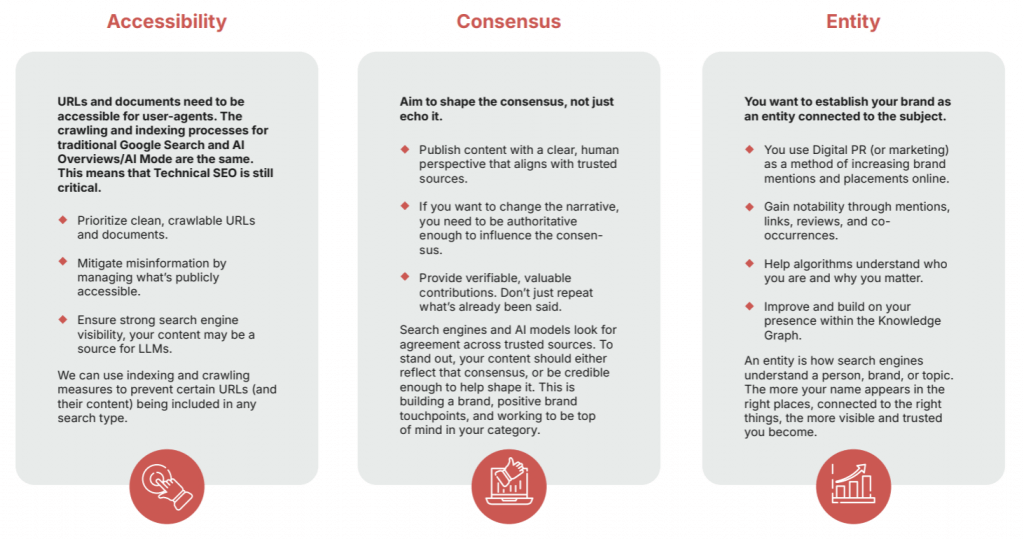The ACE Framework for LLM and AI Visibility
Large language models and AI-driven platforms are transforming how information is discovered. For organisations, the challenge is clear: how to ensure visibility within these systems.
While traditional SEO principles remain relevant, the context has shifted.
To maintain presence, three areas require attention – Accessibility, Consensus, and Entity.
Together, these form the ACE Framework.

A – Accessibility
Content that cannot be crawled, processed, or interpreted will not contribute to the AI ecosystem. Accessibility involves making information available in a form that both humans and machines can process effectively.
Crawlability is the first step. High-value pages should not be blocked by robots.txt or hidden within overly complex site structures. Clear URLs, logical internal linking, and accurate sitemaps remain essential. Content that is locked behind heavy JavaScript or authentication barriers is less likely to be indexed by AI systems.
Equally important is structure. LLMs break content into tokens, which are small units representing words or parts of words. Long and complex sentences generate more tokens, increasing the likelihood of diluted meaning.
Structured formatting, schema markup, and plain language make it easier for machines to interpret content reliably.
Accessibility also requires governance. Not all content should be open to indexing. Organisations may need to restrict access to sensitive or outdated material, manage how information is referenced, and maintain version control to ensure accuracy.
Finally, performance plays a role. Sites that are slow or poorly optimised undermine both user experience and machine evaluation. Mobile-first design, compliance with accessibility standards, and where appropriate, APIs or data feeds, all improve the likelihood of inclusion.
In summary, accessibility is not solely about allowing search engines to crawl a site. It is about ensuring that content can be processed and used meaningfully within machine-driven systems.
C – Consensus
AI systems prioritise agreement. The more information aligns with what is trusted and verifiable, the more likely it is to be surfaced in responses.
This requires publishing material supported by credible evidence, ensuring consistency across channels, and securing mentions in authoritative sources. Contradictory or inconsistent messaging weakens alignment and reduces visibility.
Consensus is not static. It evolves as industries and knowledge shift. Organisations that publish authoritative content, contribute to public discourse, and influence debates have the opportunity to shape what is recognised as accurate.
Reinforcing and clarifying established narratives strengthens a brand’s inclusion in AI-driven outputs.
E – Entity
Entities are the foundation of how AI systems organise knowledge. An entity may be a brand, a product, or an individual. The clearer and stronger the entity, the greater the likelihood that it will be identified as a reliable source.
Establishing notability is fundamental. Mentions by credible publications, inclusion in recognised databases, and consistent information across profiles such as websites and business listings provide validation. Without these signals, entities are easier to overlook.
Entities also gain authority through association. Appearances alongside established organisations, industry leaders, or relevant themes enhance credibility. Creating connections to key topics in a sector helps ensure that AI systems relate an entity to the appropriate subject matter.
Human perspective is also vital. AI tends to present generic summaries. Original commentary, clear authorship, and material grounded in genuine expertise distinguish entities and increase their authority within AI-driven systems.
Why the ACE Framework Matters
AI is not eliminating search but reshaping it. Traditional search led users through a sequence of links and comparisons. AI-driven discovery compresses this journey into direct, consensus-based responses.
The ACE Framework provides a structured approach. By ensuring accessibility, aligning with consensus, and strengthening entity presence, organisations can position themselves as credible participants in this evolving landscape.
Visibility within AI systems is not achieved through shortcuts. It requires accessible content, alignment with recognised consensus, and the development of strong entities. This is the ACE Framework, a model for sustaining visibility in an AI-first environment.